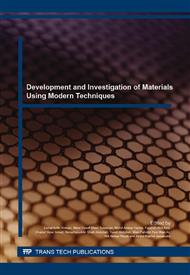p.202
p.207
p.213
p.220
p.225
p.231
p.236
p.240
p.247
Investigation of Surface Properties of Titanium Treated with Combined Alkali and Sodium Removal Treatments
Abstract:
Recent studies revealed the incorporation of sodium removal treatment in between alkali and heat treatments to prepare a sodium-free bioactive surface on titanium. This method has been reported to be more effective than conventional alkali and heat treatments to promote titanium osteointegration. This study aims to investigate the surface properties of high purity titanium after subjected to alkali treatment and subsequent sodium removal treatment. High purity titanium foils were immersed in 5 M NaOH at 60 °C for 24 hours followed by immersion in diluted HCl acid and/or distilled water at 40 °C for a period of time. The surface morphology and composition were examined using Field Emission Scanning Electron Microscope/Energy-Dispersive X-Ray Spectroscopy (FESEM/EDS). The surface wettability was evaluated by water contact angle. The surface functional groups were analysed using Fourier Transform Infrared Spectroscopy (FTIR). It was revealed that alkali and subsequent sodium removal treatments have rendered these samples high wettability and surface energy with the introduction of hydroxyl groups. Furthermore, diluted HCl treatment, water treatment and combination of both treatments removed sodium from the surfaces of alkali-treated titanium effectively (<5wt% Na) without altering existing hydroxyl groups.
Info:
Periodical:
Pages:
225-230
Citation:
Online since:
January 2016
Authors:
Keywords:
Price:
Сopyright:
© 2016 Trans Tech Publications Ltd. All Rights Reserved
Share:
Citation:


